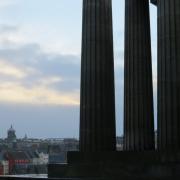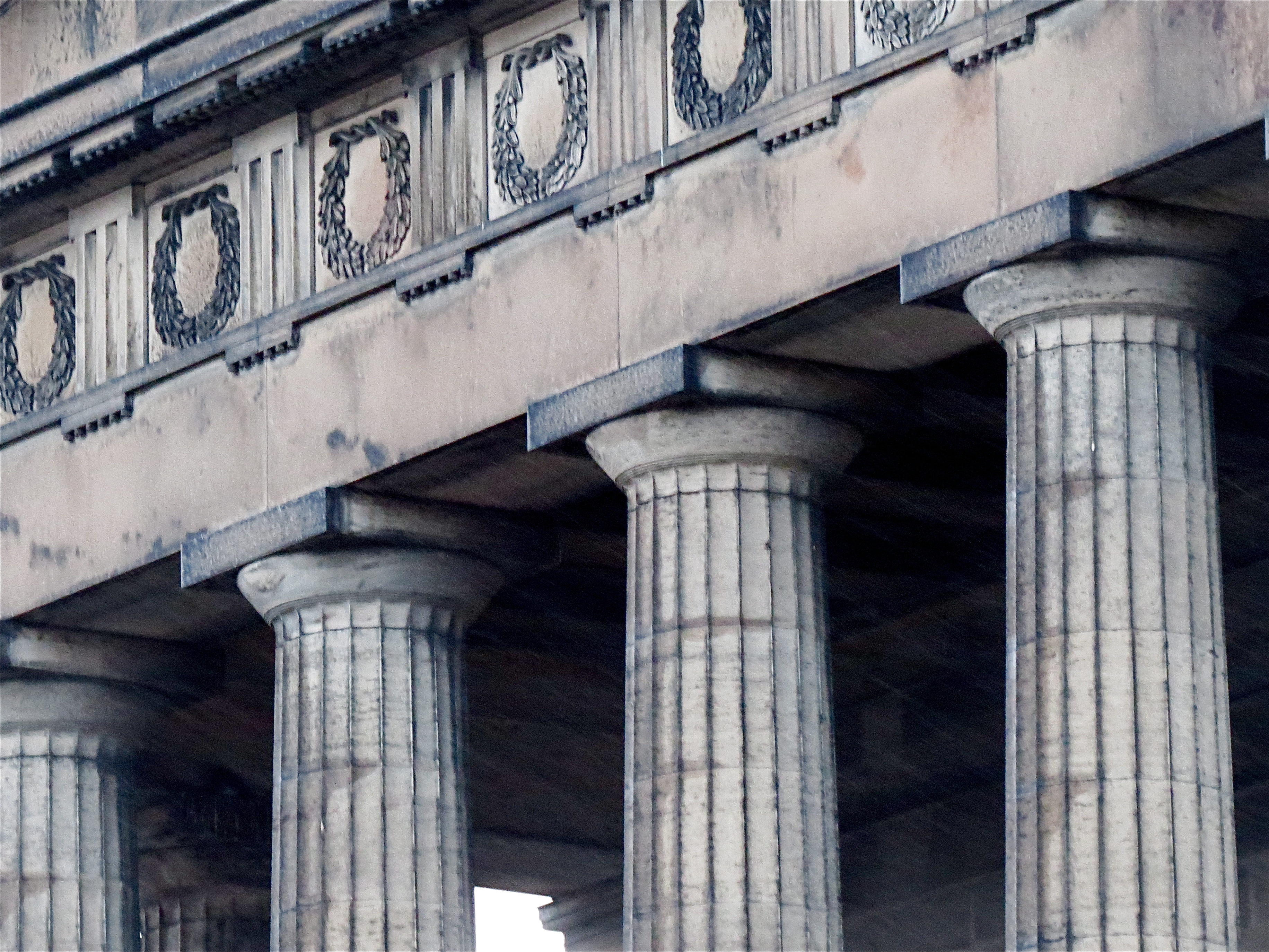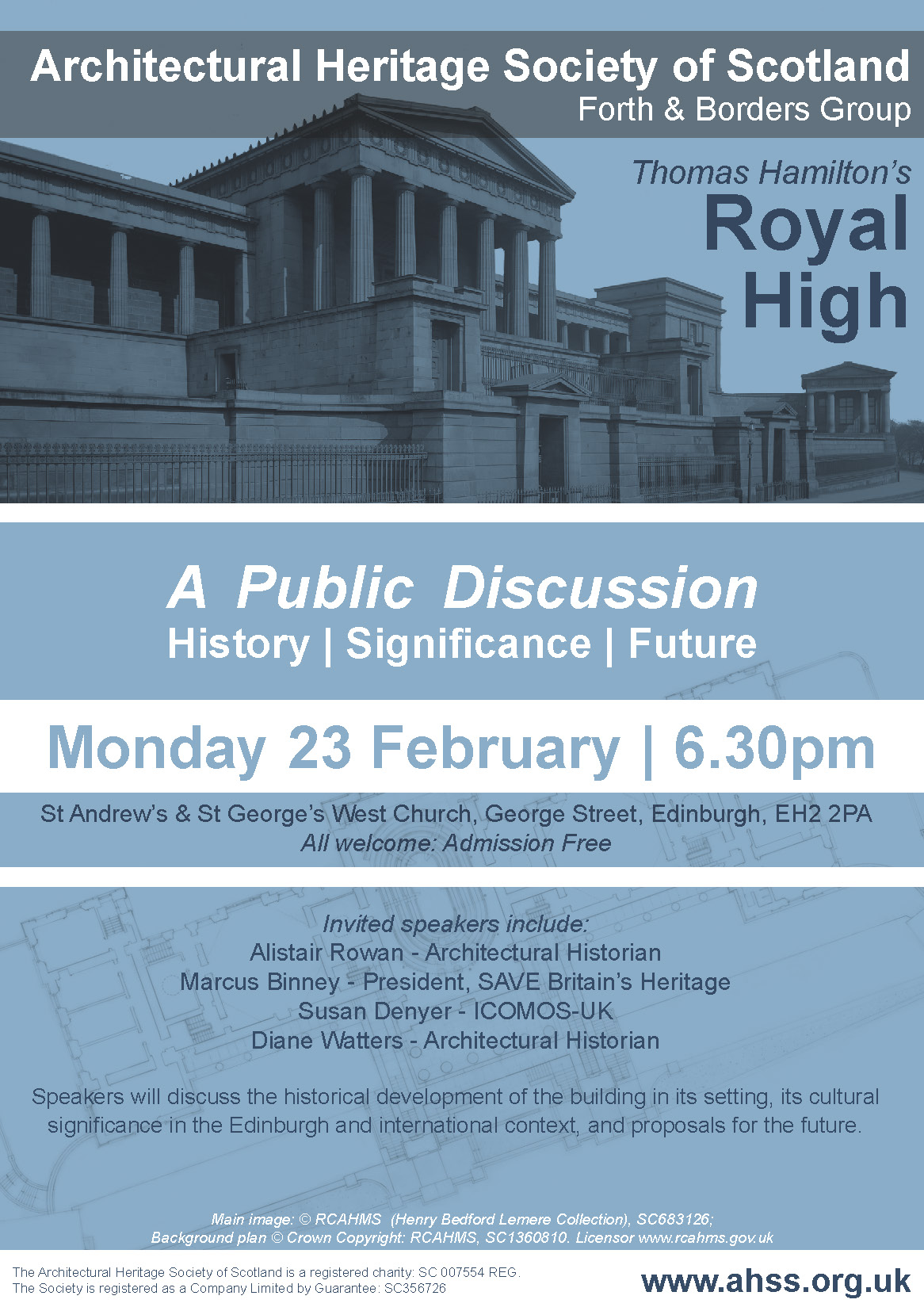
The pre-application notification for major redevelopment of the former Royal High School on Regent Road will be submitted to City of Edinburgh Council on Tuesday.
The proposal envisages a mix of luxury hotel, café/restaurant, conference/meeting rooms and exhibition space.
Duddingston House Properties (DHP) will hold public exhibitions on-site in early February and March. A full application will follow soon after.
If all goes according to DHP’s plan, the refurbished and newly extended building will open for business in 2018.
Spurtle yesterday toured the building with DHP representatives. This account is largely informed by their take on the situation. We invite readers with comments or counter-opinions of their own to get in touch.
Thomas Hamilton’s Category A-listed, classically inspired, blue-sky temple of education – responding to the national Parthenon up the hill – stands on a south-facing slope overlooking Holyrood, the Old Town and Arthur’s Seat beyond.
Begun in 1825 and completed four years later, it has long had – on sunny days – an exceptional capacity to excite and inspire.
Yesterday, in fierce winds and driving sleet, it was utterly dispiriting. No wonder it's being dubbed 'Edinburgh's new disgrace'.
Some of the wooden sashes are growing spongy, window panes are cracked, various interior walls are clammy to the touch. The building is clearly sick.
And no wonder. Since it ceased to function as a school in 1968, no established use has been found for the place. It’s owned by City of Edinburgh Council, which runs a few services out of peripheral structures in the old playground and has allegedly pumped in some £20m over the years to maintain the central Hamilton edifice.
However, since the Crash of 2008, CEC money has been prioritised on front-line services elsewhere.
Just to stabilise the building’s condition at this stage would cost an estimated £5m.
So, with this magnificent landmark at serious risk of terminal decline and no public money to save it, what is to be done?
Six years ago, CEC ran a competition, inviting potential developers to come forward with alternative futures for the site. In return for a 125-year conditional ground-lease (after which the school must return into public hands 'in no worse condition' than it left them), it wanted a sustainable use with economic and financial benefits for the city. In 2010, it selected DHP’s vision as the most viable.
DHP’s chief executive Bruce Hare acknowledges that any scheme entailing major changes to this building will be controversial. It comes with a weight of history. As 'New Parliament House', it resonates for many as a symbol of nationalist aspiration. It stands austerely on the hill, proclaiming whatever is left of Edinburgh’s Athenian pretensions.
There have been hopes over recent years that it might be converted into a Museum of Photography – appropriate, given its proximity to Hill and Adamson’s early studio next door. But like other lofty-minded possibilities (16.8.09), this soon failed for want of public funds.
DHP enlisted Scottish Development International to evaluate commercial options, and that research now points to using parts of the site as a top-of-the-market hotel.
Other hoteliers in the city welcome the prospect of such competition, says Hare. They believe it would lead to an overall raising of standards and an increase in profit margins. Currently, there’s a race to the bottom driven by an abundance of budget accommodation in the city.
Another report, by Oxford Economics, estimates that DHP’s luxury business would add £32m per year to Scotland’s GDP (£27m to Edinburgh’s) and create 740 jobs. DHP says it has whittled down 50 interested hotel groups to three ‘world-class’ operators from whom they would – if their scheme were consented – pick a partner.
Such funding is hard won (hence the delay between 2010 and now) and does not remain on the table for long. Hare claims that if consent is not granted this year, the whole project will fold.
Restoration, re-use, redevelopment
DHP plan to restore Hamilton’s centre-piece, and re-use it as conference/meeting rooms, restaurant/bar/café and exhibition space.
The last two elements are interesting not least because they would:
- be open to the public (thereby, in Spurtle’s opinion, partially mitigating the disagreeable prospect of a super-exclusive hotel patronised by the disgustingly rich)
- if sited at street level, increase footfall to Regent Road and potentially provide additional pedestrian access from the top of Calton Hill via Jacob’s Ladder to the Old Town
- constitute a significant change to the structural organisation of the building and its relationship at ground-floor level with the street.
They would, he says, rise no higher than the central string-course at the front, and match the current height of the gymnasium where they step back towards the hill. They would not encroach laterally on the Hamilton building, but would be linked to each other and the centre by glazed galleries at ground-floor level.
Few would mourn the buildings earmarked for demolition. Taking down the gymnasium would also have the interesting effect of revealing an original Hamilton tower, currently engulfed by later construction.
Overall, Hare speaks of making the ‘minimum architectural intervention possible’. He is clearly aware, though, of public scepticism, some heritage champions’ downright opposition, and nervous officials.
DHP are therefore now engaged in extensive pre-PAN consultation, and an ongoing process of charming, explaining and persuading CEC staff, private individuals, community groups and councils, and the media.
DHP are not looking at the Royal High School in isolation.
They are keen to preserve ‘key views’ of the building from elsewhere in the city, and – as mentioned earlier – to improve accessibility.
They’re looking also at improving the building’s links to the rest of Calton Hill, an area which, Hare says, itself needs urgent attention.
The hill attracts 450,000 visitors a year but has no overall management plan, only one public loo, and an 'unsavoury reputation after dark'.
Spurtle quite likes the disjointed, haphazard and exposed inadequacies of Calton Hill. They match the unfinished Disgrace at its summit, and place a morally improving strain on the bladders of otherwise pampered tourists. We also enjoy the fact that its seedy night-time economy flourishes amid so much national pomp, outwith anybody's sanitised corporate or civic management structure. However, we accept that not everyone will agree.

What is one to make of all this? In summary:
- The building in its current condition and state of maintenance will not survive.
- Merely preserving the property is not a cheap option or a good use of space.
- DHP has a researched and funded project with a choice of business partners willing to co-invest.
- That project, they claim, would benefit Edinburgh’s economy.
- That project would involve substantial reworking – some say improvement, some say desecration – of an architectural masterpiece and its immediate setting.
Spurtle has no settled view on the matter. We’ve not seen the PAN exhibition yet or studied a single artist’s impression.
But the former Royal High School is dilapidating in front of one’s eyes. Every day it becomes more expensive to preserve and more difficult to re-use.
We know opponents of the DHP proposals have well-founded reasons for their stance, and we’d like to hear more about them here in detail. But indefinite delay is not an option. There is no merit in a perfectly authentic ruin.
Achievable plans are required soon before the bus leaves without us.
Got a view? Tell us at spurtle@hotmail.co.uk and @theSpurtle and Facebook
-------------------------------------
@theSpurtle there were 54 notes of interest in redeveloping it in 2009. CEC only explored 5, whittling down to 2. We're there better ideas?
@theSpurtle CEC are responsible for the condition of Scotland's most important Greek Revival building. Simple maintenance?
@theSpurtle and I took the same pictures. Some impressive guano. pic.twitter.com/vaTMkMkNmv
Dear Spurtle
The old Royal High School is one of the most magnificent buildings in Edinburgh, and it is heartbreaking to see it in its current state … [continued in Letters, 19.1.15].
Email from Costas Dikeos: Though I stil feel that my 'proposal' is better, I am tempted to say that a bad solution is better than no solution, especially if they keep the promise for some public use and access.
*****
Dear Buildings at Risk

